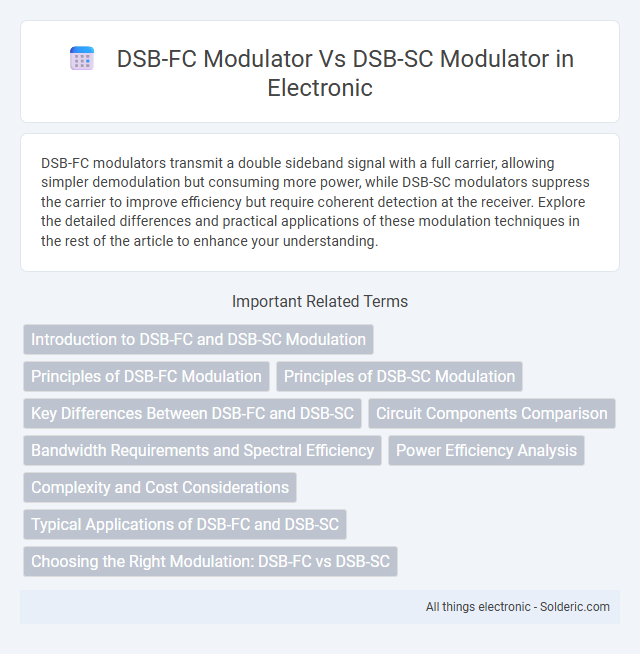DSB-FC modulators transmit a double sideband signal with a full carrier, allowing simpler demodulation but consuming more power, while DSB-SC modulators suppress the carrier to improve efficiency but require coherent detection at the receiver. Explore the detailed differences and practical applications of these modulation techniques in the rest of the article to enhance your understanding.
Comparison Table
| Feature | DSB-FC Modulator | DSB-SC Modulator |
|---|---|---|
| Full Form | Double Sideband with Full Carrier | Double Sideband Suppressed Carrier |
| Carrier Transmission | Carrier transmitted with signal | Carrier suppressed, not transmitted |
| Power Efficiency | Low, due to power in carrier | High, power used only in sidebands |
| Demodulation Method | Envelope detector (simple) | Coherent demodulation (requires carrier recovery) |
| Bandwidth | Twice the baseband bandwidth | Twice the baseband bandwidth |
| Signal Complexity | Simple transmitter and receiver | Complex receiver for coherent detection |
| Use Cases | AM broadcasting, simple systems | Communication systems requiring power efficiency |
Introduction to DSB-FC and DSB-SC Modulation
DSB-FC (Double Sideband Full Carrier) modulation transmits the entire carrier signal along with both sidebands, enabling easier demodulation but requiring more bandwidth and power. DSB-SC (Double Sideband Suppressed Carrier) modulation eliminates the carrier, sending only the sidebands, which improves power efficiency and bandwidth usage at the expense of more complex receiver design. Your choice between DSB-FC and DSB-SC modulators depends on the trade-off between transmission power, bandwidth constraints, and receiver complexity.
Principles of DSB-FC Modulation
DSB-FC modulation involves transmitting a double-sideband signal along with a full carrier, which allows for simpler demodulation using envelope detection, making it suitable for AM radio transmissions. The principle relies on varying the amplitude of the carrier wave directly with the baseband message signal while maintaining the carrier frequency constant. Your choice of a DSB-FC modulator benefits from easy receiver design but at the cost of transmitting additional carrier power, unlike DSB-SC which suppresses the carrier for higher efficiency.
Principles of DSB-SC Modulation
DSB-SC modulation is based on multiplying the message signal with a carrier wave, producing a double sideband suppressed carrier output that improves power efficiency by eliminating carrier transmission. This principle maintains the full information content in the sidebands while reducing bandwidth usage compared to standard DSB-FC modulation. Your communication system benefits from increased signal-to-noise ratio and better utilization of spectrum resources with DSB-SC modulators.
Key Differences Between DSB-FC and DSB-SC
DSB-FC modulators transmit signals with a full carrier, making them easier to demodulate but less power-efficient than DSB-SC modulators, which suppress the carrier and only transmit sidebands. The presence of the carrier in DSB-FC increases bandwidth usage and power consumption, while DSB-SC optimizes bandwidth and power by eliminating the carrier component. Your choice depends on the trade-offs between power efficiency and demodulation complexity required for your communication system.
Circuit Components Comparison
DSB-FC modulators utilize a carrier oscillator, multiplier, and low-pass filter to generate the modulated signal, whereas DSB-SC modulators typically employ a balanced mixer and carrier oscillator without the need for a filter. The presence of a carrier in DSB-FC ensures easier carrier recovery for demodulation but increases circuit complexity, unlike the suppressed carrier in DSB-SC, which simplifies the power amplifier requirements. Key components differentiating the two include the low-pass filter in DSB-FC circuits and the balanced mixer stage in DSB-SC modulators.
Bandwidth Requirements and Spectral Efficiency
DSB-FC modulators require a bandwidth equal to twice the highest frequency of the message signal plus the carrier frequency, resulting in less spectral efficiency compared to DSB-SC modulators, which use only twice the message bandwidth due to suppressed carrier transmission. The presence of a carrier in DSB-FC increases power consumption and spectral occupancy, making DSB-SC more bandwidth-efficient for communication systems aiming to maximize channel capacity. Your choice of modulator affects how effectively the available spectrum is utilized, with DSB-SC offering better spectral efficiency for bandwidth-limited scenarios.
Power Efficiency Analysis
DSB-FC (Double Sideband Full Carrier) modulators consume more power due to the continuous transmission of the carrier signal, leading to lower power efficiency compared to DSB-SC (Double Sideband Suppressed Carrier) modulators. The DSB-SC modulator eliminates the carrier during transmission, significantly reducing power waste and improving overall power efficiency. For your communication system, choosing a DSB-SC modulator can effectively minimize power consumption while maintaining signal integrity.
Complexity and Cost Considerations
DSB-FC modulators incorporate a carrier signal making their design simpler and less costly compared to DSB-SC modulators, which require precise carrier suppression and more complex circuitry. The presence of the carrier in DSB-FC reduces the need for coherent detection hardware, lowering overall system expenses. Consequently, DSB-FC modulators are preferred in applications where minimizing complexity and cost is crucial despite potential bandwidth inefficiency.
Typical Applications of DSB-FC and DSB-SC
DSB-FC modulators are commonly used in AM radio broadcasting and commercial communication systems where carrier transmission improves signal detection and simplicity of receivers. DSB-SC modulators find typical applications in point-to-point microwave communication and suppressed carrier systems where bandwidth efficiency and power savings are critical. Your choice between these modulators should consider the trade-off between transmission efficiency and ease of demodulation.
Choosing the Right Modulation: DSB-FC vs DSB-SC
DSB-FC (Double Sideband Full Carrier) modulators transmit both the carrier and sidebands, facilitating easier demodulation with simpler receivers but consuming higher power and bandwidth. DSB-SC (Double Sideband Suppressed Carrier) modulators eliminate the carrier, enhancing power efficiency and bandwidth utilization at the cost of requiring coherent detection and more complex receiver design. Selecting between DSB-FC and DSB-SC depends on system constraints such as power availability, receiver complexity, and the need for efficient spectrum usage.
DSB-FC modulator vs DSB-SC modulator Infographic

 solderic.com
solderic.com